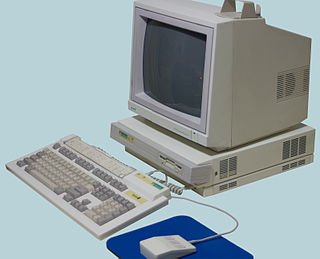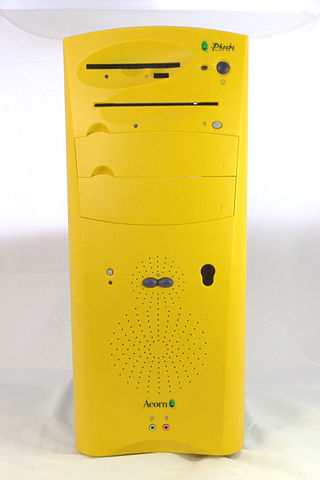Related Research Articles

Acorn Computers Ltd. was a British computer company established in Cambridge, England, in 1978. The company produced a number of computers which were especially popular in the UK, including the Acorn Electron and the Acorn Archimedes. Acorn's BBC Micro computer dominated the UK educational computer market during the 1980s.

Acorn Archimedes is a family of personal computers designed by Acorn Computers of Cambridge, England. The systems are based on Acorn's own ARM architecture processors and the proprietary operating systems Arthur and RISC OS. The first models were introduced in 1987, and systems in the Archimedes family were sold until the mid-1990s.

RISC OS is a computer operating system originally designed by Acorn Computers Ltd in Cambridge, England. First released in 1987, it was designed to run on the ARM chipset, which Acorn had designed concurrently for use in its new line of Archimedes personal computers. RISC OS takes its name from the reduced instruction set computer (RISC) architecture it supports.

LilyPond is a computer program and file format for music engraving. One of LilyPond's major goals is to produce scores that are engraved with traditional layout rules, reflecting the era when scores were engraved by hand.

Sibelius is a scorewriter program developed and released by Sibelius Software Limited. It is the world's largest selling music notation program. Beyond creating, editing and printing music scores, it can also play the music back using sampled or synthesised sounds. It produces printed scores, and can also publish them via the Internet for others to access. Less advanced versions of Sibelius at lower prices have been released, as have various add-ons for the software.

The Phoebe 2100 was to be Acorn Computers' successor to the RiscPC, slated for release in late 1998. However, in September 1998, Acorn cancelled the project as part of a restructuring of the company.
A scorewriter, or music notation program is software for creating, editing and printing sheet music. A scorewriter is to music notation what a word processor is to text, in that they typically provide flexible editing and automatic layout, and produce high-quality printed results.

SCORE is a scorewriter program, written in FORTRAN for MS-DOS by Stanford University Professor Leland Smith (1925–2013) with a reputation for producing very high-quality results. It was widely used in engraving during the 1980s and 1990s and continues to have a small, dedicated following of engravers, many of whom hold the program in high regard due to its ability to position symbols precisely on the page. Several publications set using SCORE have earned Paul Revere and German Musikpresse engraving awards.
MusicXML is an XML-based file format for representing Western musical notation. The format is open, fully documented, and can be freely used under the W3C Community Final Specification Agreement.
Timeworks Publisher was a desktop publishing (DTP) program produced by GST Software in the United Kingdom.
The Werner Icking Music Archive is a web archive of liberally licensed sheet music of public domain music. The scores are electronically typeset by volunteers and distributed in PDF, often accompanied by their typesetting files. WIMA continues the defunct GMD Music Archive and is named after its founder, the late Werner Icking. After a merge completed in 2012, the archive forms part of the International Music Score Library Project (IMSLP).

Mozart the music processor is a proprietary WYSIWYG scorewriter program for Microsoft Windows. It is used to create and edit Western musical notation to create and print sheet music, and to play it via MIDI.

Overture is a music notation (scorewriter) program for Windows and Macintosh platforms, published and developed by Sonic Scores. While Overture is primarily a scorewriter program, it also allows editing the score's MIDI audio playback data in the manner of sequencer and digital audio workstation (DAW) software.
Computational musicology is an interdisciplinary research area between musicology and computer science. Computational musicology includes any disciplines that use computation in order to study music. It includes sub-disciplines such as mathematical music theory, computer music, systematic musicology, music information retrieval, digital musicology, sound and music computing, and music informatics. As this area of research is defined by the tools that it uses and its subject matter, research in computational musicology intersects with both the humanities and the sciences. The use of computers in order to study and analyze music generally began in the 1960s, although musicians have been using computers to assist them in the composition of music beginning in the 1950s. Today, computational musicology encompasses a wide range of research topics dealing with the multiple ways music can be represented.
This is a comparison of music notation programs.
The Norcroft C compiler in computing is a portable set of C/C++ programming tools written by Codemist, available for a wide range of processor architectures.
In computing, MakeModes is an application which is used to generate data which allows RISC OS computers to produce display output compatible with various computer monitors. It can generate and modify data which is used by the operating system to produce different graphics display resolutions.
Musink is a scorewriting computer program for Windows and macOS. It is a WYSIWYM editor, with automated music- and page-layout functionality. Two versions of Musink exist: Musink Lite, which is freeware; and Musink Pro, which is not free but contains additional features.
References
- 1 2 3 4 5 6 7 8 9 10 11 12 Hazel, Philip. "Whatever Happened to Philip's Music Scribe?". Qercus . No. 281. pp. 15–18. Retrieved 2013-06-13.
- 1 2 Selfridge-Field, Eleanor; Correia, Edmund Jr. "Musical Information in Musicology and Desktop Publishing". Center for Computer Assisted Research in the Humanities . Retrieved 2013-06-13.
- 1 2 "Philip's Music Writer".
- 1 2 Hazel, Philip (1997). "Philip's Music Scribe". In Selfridge-Field, Eleanor (ed.). Beyond Midi: The Handbook of Musical Codes. MIT Press. pp. 232–251. ISBN 978-0-262-19394-8 . Retrieved 13 June 2013.
- 1 2 "Philip's Music Writer". Freecode website. Freecode . Retrieved 2013-06-13.
- 1 2 Hazel, Philip. "Philip's Music Writer" (PDF). Retrieved 2013-06-13.
- ↑ Brett, Paul. "PD World". RISC World . Retrieved 2013-06-13.
- ↑ Computing in Musicology. Center for Computer Assisted Research in the Humanities. 1993. p. 213. ISBN 9780936943084 . Retrieved 13 June 2013.